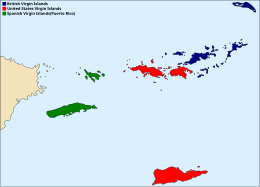Virgin Passage

The Virgin Islands, with Puerto Rican territory in green, United States Virgin Islands in red, and British Virgin Islands in blue
|
|
| Geography | |
|---|---|
| Location | Caribbean Sea, Atlantic Ocean |
| Archipelago | Leeward Islands |
| Administration | |
| Insular area | United States Virgin Islands |
| Unincorporated territory | Puerto Rico |
| Overseas territory | British Virgin Islands |
The Virgin Islands are the western island group of the Leeward Islands, which are the northern part of the Lesser Antilles, and form the border between the Caribbean Sea and the Atlantic Ocean. Politically, the group is divided into the British, Puerto Rican and US Virgin Islands. The archipelago is separated from the Renaissance Islands by the Anegada Passage and from the main island of Puerto Rico by the Virgin Passage.
Christopher Columbus named the islands after Saint Ursula and the 11,000 Virgins (Spanish: Santa Úrsula y las Once Mil Vírgenes), shortened to the Virgins (las Vírgenes). The official name of the British territory is the Virgin Islands, and the official name of the U.S. territory is the Virgin Islands of the United States. In practice, the two island groups are almost universally referred to as the British Virgin Islands and the U.S. Virgin Islands.
The Virgin Islands were originally inhabited by the Arawak, Carib, and Cermic, almost all of whom are thought to have perished during the colonial period due to enslavement, foreign disease, and mass extermination brought about by European colonists as is the case in the rest of the Caribbean.
European colonists later settled here and established sugar plantations, at least one tobacco plantation, and purchased slaves acquired from Africa. The plantations are gone, but the descendants of the slaves remain the bulk of the population, sharing a common African-Caribbean heritage with the rest of the English-speaking Caribbean.
...
Wikipedia
